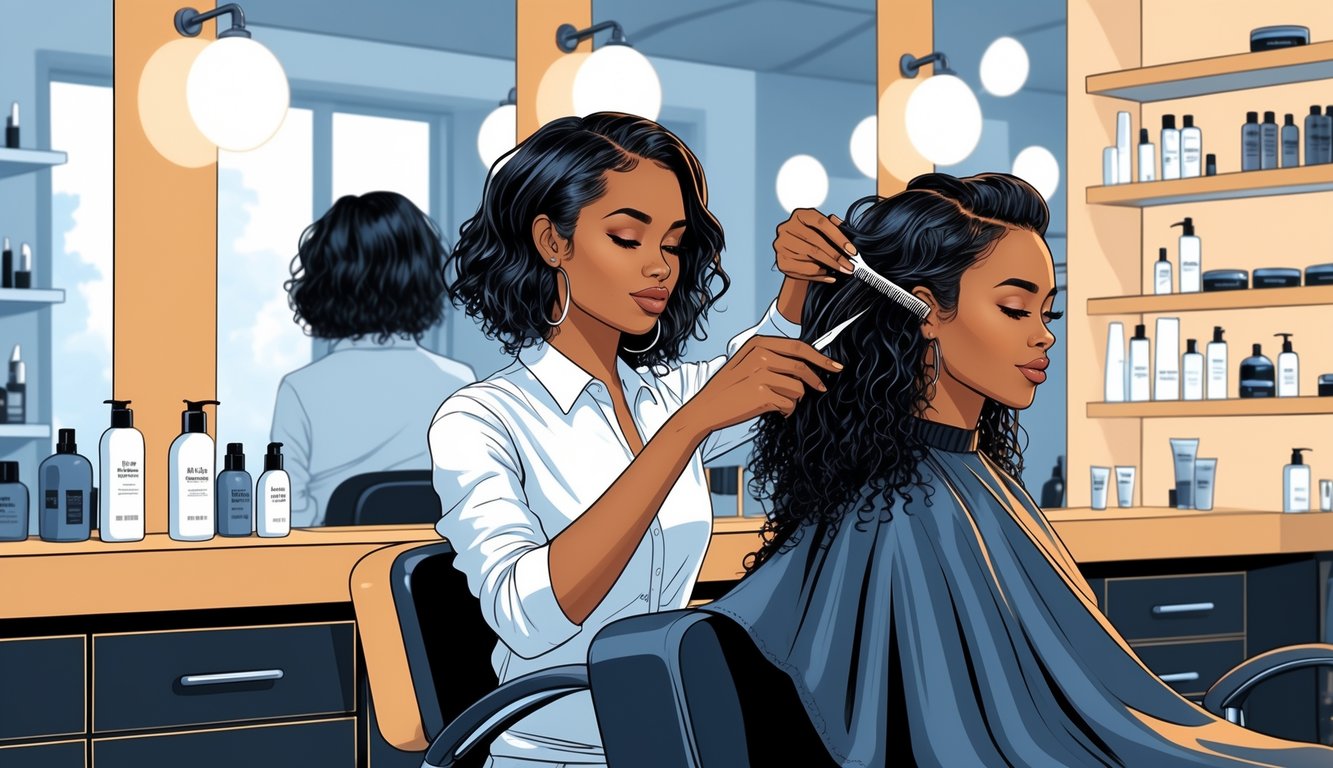
Cutting and Shaping Techniques for Textured Hair
What drives me up the wall? Stylists who grab the same shears and do a “standard” cut, like all textured hair is identical. It’s not. Ignore curl pattern, porosity, or that one stubborn cowlick, and you’ll botch the shape almost every time. You have to pay attention to where hair springs up or where the bulk hides, or you’re just sending people home with hats.
Customizing Haircuts Based on Texture
Once, a newbie stylist thinned curly hair from the inside out. By noon, the client’s crown exploded—mushroom city. Layering textured hair is nothing like chopping a straight bob. I’ve seen people lose years of growth because someone went in with blunt scissors and no plan. What should stylists actually do? Use deep point cutting, try twist cutting (not for every curl, don’t get cocky), and sometimes internal cutting for movement without killing volume. Elevate the hair vertically to remove bulk. Old-school mistake: cutting everything horizontal. That flattens the shape in seconds. I tell assistants: never texturize curly hair wet unless you want a mess. Over-texturizing is a nightmare—one bad slide cut and you’ve got a hole that won’t disappear for months. Volumizing mousse and curl creams? Good. Heavy wax? Forget it, unless you want every curl to clump and sulk.
Considering Face Shape With Every Cut
Alright, confession time: I can’t start a haircut without basically staring at someone’s face like a forensic sketch artist. Jawline, forehead, weird bumps—my brain’s just ticking through face shape stuff automatically. I know, it sounds obsessive. But if you’ve got an oval face, I’m thinking, “go for cheekbone layers.” Round face? Please, don’t let me chop off too much at the bottom unless you want to see your cheeks double in size—been there, regretted that. Rectangle faces are trickier. Put a bunch of hair right next to the chin and suddenly you’re starring in a bad ‘80s sitcom.
Saw a stylist last week do these blunt, horizontal bangs on a square face, then layer everything right up to the chin. Client’s face said it all—total disaster. Soft graduation (which, yes, is just shifting your section angles and sneaking in C-shapes) makes lines look less harsh, especially if the hair’s textured. I keep thinking about those celebrity stylists who go on and on about balancing texture distribution—and honestly, I haven’t seen a single person regret it.
But here’s the thing that bugs me: some stylists carry these “face shape” diagrams in their kits, like humans are geometry problems. No one’s a perfect oval or square. Ever met someone with a symmetrical head? Me neither. Sometimes I’ll just wing it because there’s a wild cheekbone or a cowlick from hell. It’s chaotic and, honestly, probably not what they taught in hair school, but people seem to like it. Or maybe they’re just being polite? Hard to tell.
Moisture Management: Avoiding and Correcting Dryness
I’ve lost count of how many times I see breakage and people just go, “Eh, bad hair genes.” No, it’s not genetics, it’s skipping real moisture routines. Textured hair dries out in, like, five minutes if you ignore it, and then you’re chasing frizz and knots and wondering why your brush is full of broken pieces. If you don’t have a conditioner or some kind of moisture-boosting product, good luck. And don’t get me started on the whole moisture-protein balancing act—nobody warned me it would matter this much.
Deep Conditioning for Lasting Hydration
People complain their conditioner “does nothing” and then admit they rinse after two minutes—why even bother? Deep conditioning, I swear, is one of those phrases stylists throw around like everyone knows what it means. If you want my two cents, slap on a thick, protein-free mask for at least 20–30 minutes. Heat helps—seriously, even a shower cap is better than nothing.
Silicones, yeah, people argue about them, but honestly, deep conditioning works whether you’re “coating” or “sealing”—which, by the way, aren’t the same thing. Had this client who literally scheduled Saturday deep conditioning dates with her teenager. Cut their detangling time in half. If your hair still feels rough or snaps off, check for moisture loss signs—split cuticles, sudden dryness, breakage that sneaks up out of nowhere. Set up a routine unless you’re allergic to results. Hydration isn’t about a shiny top layer, it’s about getting moisture into the cortex. Yeah, I’m still not sure how that works, but it does.
Choosing Moisture-Boosting Products
Here’s what makes me want to scream: people using body lotion on their hair because it says “moisturizing.” I wish I was joking. Products for textured hair usually have humectants (glycerin, honey) and emollients (shea butter, olive oil, coconut oil). Curl creams, leave-ins, hair milks—they all play nice together, but climate and porosity change everything.
I keep telling people “hydrating” means water-based, not just dumping oil on your head. Get it wrong and you’ll get buildup, dullness, and rough hair that not even your strongest edge control can save. I test everything on myself first, mostly because I don’t trust labels. Still dry after all that? Maybe your hair’s just high porosity—here’s why that’s a thing. My secret weapon: aloe vera juice. Lightweight, sneaky, and works even when everything else flakes out.
Balancing Moisture and Protein
And then, just when you think your hair’s finally “moisturized,” it turns stiff and weird for no reason. Clients blame trims, but it’s almost always protein overload. If your hair feels like straw or crunches when you touch it, maybe you did too many protein treatments or used the wrong “strengthening” conditioner. You’ve gotta rescue it with moisture, and fast. Haircare research says it’s a moving target—hair wants both elasticity from moisture and strength from protein, but too much of either? Breakage city.
I’ve started telling people to keep a “feel” journal for two weeks—write down when your hair feels brittle or mushy. Sounds weird, but it works. Deep moisture masks after protein, and don’t double up on keratin shampoos unless you like brittle spaghetti. The “more is better” myth is everywhere, but over-moisturized hair just gets limp and frizzy, too. Alternating weekly between moisture and protein treatments usually helps, but nobody warns you when you’ve crossed the line—until your hair snaps, and then it’s too late.



